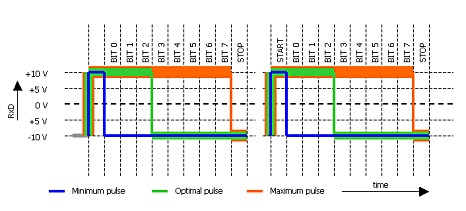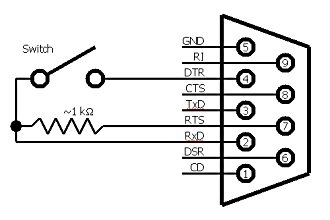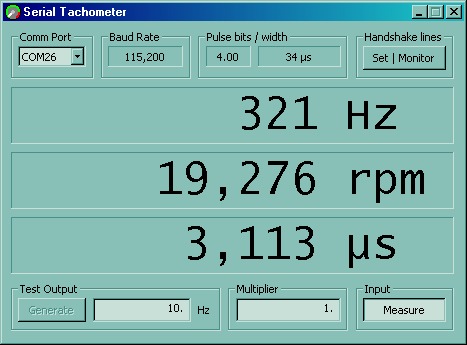17-Feb-2011
| Updated 17-Feb-2011 |
Serial Tachometer is a freeware utility program for Microsoft Windows
that uses standard PC serial port to measure pulse frequencies in range from 1 Hz to 11 kHz.

The tachometer senses pulses on the RxD input of a standard PC serial port, making the PC hardware and device driver believe the pulses are valid characters by assessing average pulse width and "hunting" for an optimal baud rate. This imposes three important limitations:
 |
||
| It can be this primitive... |
External hardware needs not to be sophisticated for the Serial Tachometer to work. If a mechanical contact is used to generate the pulses, only one resistor (almost any value >100 Ω will do), a few wires, and a cable with a female DB9 connector is all you need. Depending on the switch's "phase polarity", you need to select proper state of the DTR and RTS signal, respectively.
If the external circuit is galvanically connected to other hardware, it is a good idea to protect the RxD input with a resistor and Zener diodes or with an opto-isolator, as excessively high voltage may damage your computer. Even with diodes, serial port inputs don't usually survive direct connection to household mains (110 or 220 V AC). Since most modern computers come with serial ports integrated in their mainboard chipset, it's a whole mainboard that goes if you blow a port.
Although not designed for the purpose, DTR and RTS handshake outputs of a typical serial port can be used to power a low-consumption circuit (e.g. transistor side of an opto-isolator feeding the RxD input). The Serial Tachometer therefore supports custom setting of the handshake lines to desired polarity to provide suitable supply voltage. Again, it is a good idea to protect the powered circuit with serial diods, and the outputs from accidental shorting, by serial resistors, as state of the handshake lines is not guaranteed and can certainly change (resulting in inverted polarity) during boot or while running other applications accessing COM ports. Remember, typical output voltage on a handshake line is ±15 V, which can destroy chips designed to take only +5 V supply or lower.

Download Release 1.1.14
You may also need Microsoft Redistributable libraries for VC9 Service pack 1
The application does not have an install/uninstall procedure. Simply copy the .exe file to a convenient utility directory in your system (or make one under Program Files) and run it from there. To replace an older version, simply override it with a new one.
To completely remove all traces of Serial Tachometer from a system, delete SerialTacho.exe. Then (using regedit or regedt32) delete the following key in the system registry:
HKEY_CURRENT_USER\Software\Hroch\SerialTacho
If the program was run under various users, you may have to remove registry entries from each user's
profile.
The Serial Tachometer utility (hereinafter the Software) may be used and distributed by anyone free of charge under the following conditions:
The Serial Tachometer utility is Copyright (c) 2004-2011 by Sid Paral. All rights reserved.
| Release | Features and Bugfixes |
| 1.01.14 17-Feb-2011 |
|
| 1.00.12 13-Feb-2004 |
|
| 1.00.11 12-Feb-2004 |
|
| 1.00.10 11-Feb-2004 |
|
| 1.00.09 10-Feb-2004 |
|
Please e-mail the author with comments, suggestions, bug reports. Thanks.
| A HROCH.NET document | Copyright (c) 2004-2011 by Sid Paral. All rights reserved. |